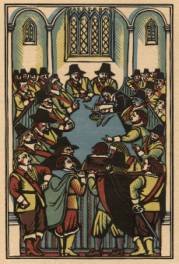
The Revolutionaries Debate - Putney 1647
Written in 2012
Choruses from the Revolution
SAB Choir
8 minutes
Difficulty level: Moderate amateur
This set of choruses have been arranged from my chamber opera about the political revolution which followed the English Civil War. It was then that demands, revolutionary at the time, for one-person-one-vote and freedom of speech and belief, were first raised.
The opera dealt with these demands, and their defeat as England descended into military dictatorship. The opera is based on text from original sources. The operatic characters, such as Cromwell and Charles I, sang words which the historical characters spoke.
The people of the time read the Bible politically, and of course the King James version is written in the same style of seventeenth-century English as that spoken by the characters in the opera. Texts from the books of Isaiah and the Psalms were therefore used for the choruses, since they gave inspiration to the revolutionaries of the time.
Many of these texts resonate in a contemporary context. Phrases such as 'bring down them that dwell on high', or 'nation shall not take up sword against nation' have a direct relevance to modern political issues. Equally, some of the texts express a sense of bleakness at environmental destruction. The texts used have been detached from their original religious meaning.
The titles of the numbers are:
1. The Earth is Defiled
2. Your land is desolate
3. How Long Shall the Wicked Triumph
4. They're Filthy
5. By the Rivers of Babylon/The Expectation of the Poor
6. The People that Walked in Darkness
7. Of Whom Shall I Be Afraid
8. Let the Heavens Rejoice/Bring Down Them that Dwell on High
1. The Earth is Defiled
2. Your land is desolate
3. How Long Shall the Wicked Triumph
4. They're Filthy
5. By the Rivers of Babylon/The Expectation of the Poor
6. The People that Walked in Darkness
7. Of Whom Shall I Be Afraid
8. Let the Heavens Rejoice/Bring Down Them that Dwell on High
The eight numbers have been have arranged so that they begin
with devastation and desolation and move through demands towards a sense of triumph. They may be performed separately, or in smaller selections.
The style is a combination of popular music styles – some have similarities to numbers from Musicals, and some are sung with a swing. The style also draw on hymn tunes, which originated as popular music. This combination of references to popular music
styles, yet complex and highly political content, was the basis of the style of the opera.
The choruses are fairly easy to sing, with no extremities of range, and and for much of the time the three parts are in rhythmic unison.
There is a piano part which adds considerable to the choruses, though they may be performed without it. They are intended to be suitable for performance in many contexts, from concerts halls to demonstration.
